7 genetically modified animals that glow in the dark
This is no party trick. These radiant sheep, dogs, and cats help further research of human diseases

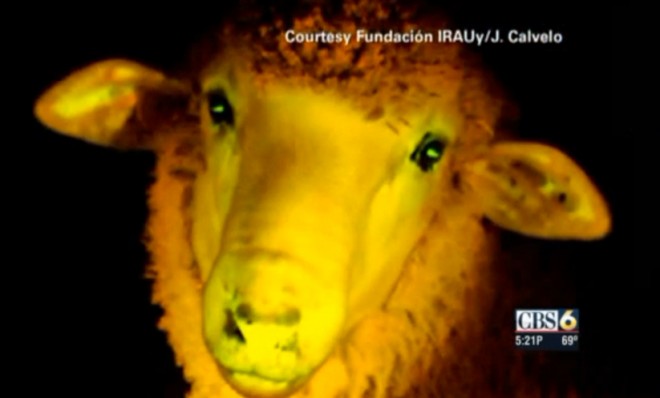
1. Sheep
Good news, nighttime shepherds: Sheep can now glow in the dark. Well, technically, only nine of the wooly animals can. And they're in Uruguay.
When these sheep were born in October 2012, scientists at the Animal Reproductive Institute of Uruguay immediately injected them with a green protein found in the Aequorea Victoria jellyfish. As the sheep grew, they looked and acted like any other four-legged balls of fluff, except that they gave off a greenish glow after being exposed to certain ultraviolet light. Check 'em out:
The Week
Escape your echo chamber. Get the facts behind the news, plus analysis from multiple perspectives.

Sign up for The Week's Free Newsletters
From our morning news briefing to a weekly Good News Newsletter, get the best of The Week delivered directly to your inbox.
From our morning news briefing to a weekly Good News Newsletter, get the best of The Week delivered directly to your inbox.
Typically, these green fluorescent proteins are used to monitor the activity of altered genes. They have proved to be of great help in the study of diseases. In fact, the method's scientific pioneers were awarded the Nobel Prize for chemistry in 2008. In the case of these sheep, scientists hope that one day they'll be able to use this sort of procedure to create animals with super health-boosting milk. Here, a look back at the radiant animals at the center of these genetic studies throughout the last decade.
2. A rabbit
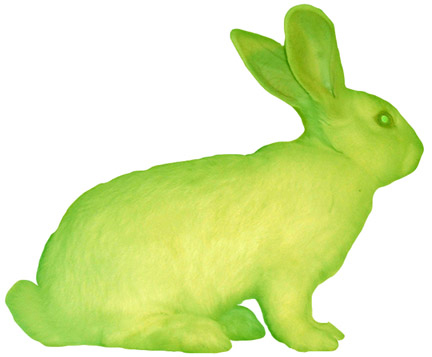
(Ekac.org/Chrystelle Fontaine)
This endeavor was actually an artistic one. Eduard Kac is an artist known to use genetic engineering techniques to create unique living works of art. In May 2000, Kac introduced the world to his "GFP bunny," an albino rabbit named Alba that glowed fluorescent when exposed to blue light. Alba was actually just one component of the project, which was also supposed to include a public debate about the practice of manipulating genes in animals for research. Kac wanted to conclude the project by taking Alba home to live with his family. A research institute in France actually created the rabbit for Kac — the florescent jellyfish protein was injected into a fertilized rabbit egg — and later hesitated over releasing the animal due to protests from animal rights groups over Alba's very creation. The scientists also claimed that they never agreed for Kac to take the bunny home. Two years after Alba was born, and long before Alba could make her trip to the states, the unique rabbit died — an abrupt end to the battle between science and art.
A free daily email with the biggest news stories of the day – and the best features from TheWeek.com
3. Pigs
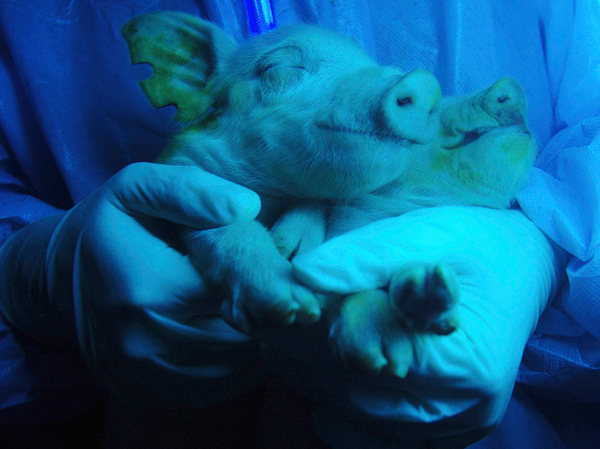
(REUTERS/China Daily)
In 2008, scientists in Taiwan claimed to have a world first: Pigs that glowed from the inside out. While other researchers had bred partially fluorescent pigs, these genetically modified pigs had not only glowing skin and eyes, but also organs, including the heart. Scientists added DNA from fluorescent jellyfish to more than 260 pig embryos, which were then implanted into eight different sows, four of which became pregnant. The result was three male piglets whose eyes, teeth, and snouts had a slightly greenish tint during the day, but would glow entirely green in the dark after being introduced to a blue light.
4. Monkeys
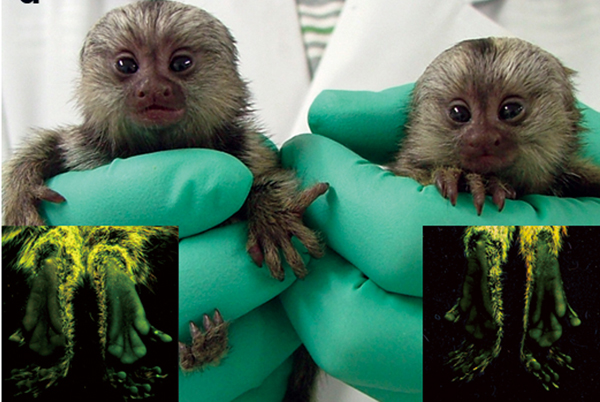
Newborn transgenic marmosets Kei (left) and Kou, and their feet under ultraviolet light. (AP Photo/Erika Sasaki)
In this 2009 study, the same jellyfish DNA injection was used, but for different purposes. Scientists in Japan wanted to see if the jellyfish gene was inherited by the second generation of a genetically modified monkey. The team at the Central Institute for Experimental Animals in Kawasaki, Japan, added a fluorescent gene to the marmoset embryos, which were then transferred into surrogate females who produced five live births. All of the modified marmosets carried the genes in their body. When they produced offspring, two passed the fluorescent gene onto their young. This was the first time a genetically modified animal passed such genes down a generation. Researchers said it could be a major step in understanding Parkinson's and motor neuron disease.
5. Dogs
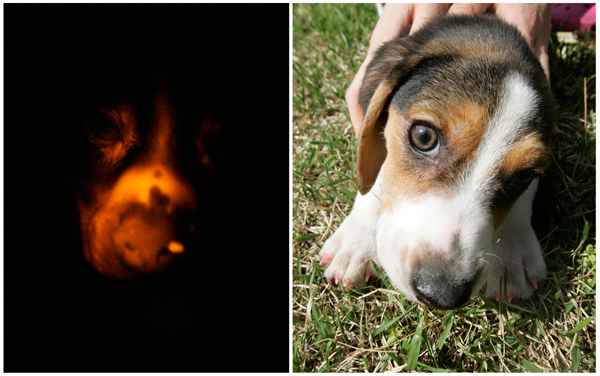
A 3-month-old beagle glows in the dark under ultra-violet light (left) but looks like any other puppy in the daylight. (REUTERS/Jo Yong-Hak)
A 2009 experiment by a team at Seoul National University reportedly produced the first transgenic dog. Five beagles were created by cloning fibroblast cells that express a red florescent gene produced by sea anemones. Under natural light you can see the faint essence of the red protein under the pale skin. In the dark and under an ultraviolet light, the dogs glow a reddish orange. The five healthy dogs eventually grew to spawn their own florescent offspring. The experiment was meant to prove the principle of transgenic animals, particularly dogs, who, due to their lifespan and reproductive cycle, are good stand-ins for human disease research. Two years later, a team at the same university bred a beagle name Tegon whose fluorescent gene could be controlled. When the dog eats food containing a doxycycline antibiotic and then is exposed to ultraviolet light, it glows green. When the drug is no longer added to the food, the glow eventually fades. Scientists say the study opens opportunities for better understanding genes that trigger fatal diseases, like Alzheimer's and Parkinson's, in humans.
6. Cats
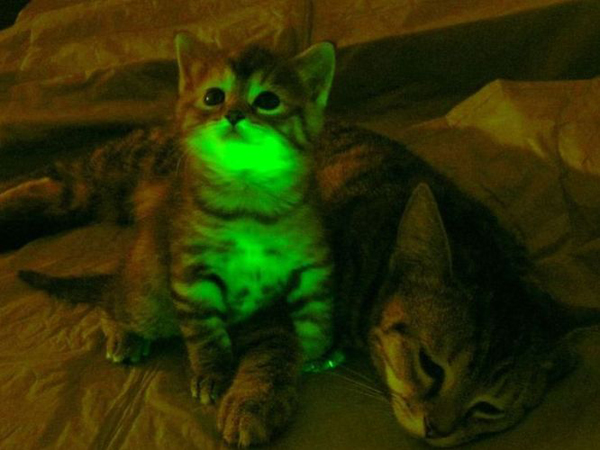
A glowing kitten stands next to a normal cat (Mayo Clinic)
Cats are susceptible to a close relative of HIV called feline immunodeficiency virus. The viral disease infects mostly feral cats, of which there are reportedly a half a billion in the world. In a 2011 study, a team of scientists from the U.S. and Japan inserted a gene into cats that helps them resist this feline form of AIDS. Then, to be able to easily mark the cells, scientists also inserted the green fluorescent protein. Both genes were transferred into feline eggs. They were then able to more readily monitor how the resistant gene developed in the cats' bodies when looking at them under a microscope. Like the other animals, the cats appeared normal during the day, but could glow at night if prompted.
7. Fish
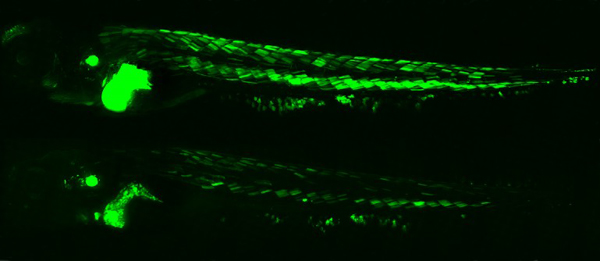
One of the biggest downsides to helpful industrial products like, say, plastic, or female contraceptives, is that they contain bad chemicals called endocrine disrupters. These substances become pollutants that harm animal and human bodies. They have reportedly been associated with lower sperm counts and breast and testicular cancers. So you can see why scientists may want to study them. The problem has been that it is difficult to track the endocrine disrupters once they enter the body. And so a team of scientists used green fluorescent proteins and genetically engineered zebrafish to glow in places where an endocrine-disrupting chemical is present. As we've previously illustrated, the fluorescent protein doesn't interfere with the body, but, when studied under a microscope, can be easily found. The glowing green areas within the fish then become a roadmap for scientists homing in on the pollutants' potential health impacts.
Sources: ABC News, BBC, Discovery, The Guardian, National Geographic, NBC News, New Scientist (2), The Register, Taipai Times
Lauren Hansen produces The Week’s podcasts and videos and edits the photo blog, Captured. She also manages the production of the magazine's iPad app. A graduate of Kenyon College and Northwestern University, she previously worked at the BBC and Frontline. She knows a thing or two about pretty pictures and cute puppies, both of which she tweets about @mylaurenhansen.
-
 Received a gift card this holiday season? Here’s how to maximize it.
Received a gift card this holiday season? Here’s how to maximize it.The Explainer Make the most of your present
-
 ‘Lumpy skin’ protests intensify across France as farmers fight cull
‘Lumpy skin’ protests intensify across France as farmers fight cullIN THE SPOTLIGHT A bovine outbreak coupled with ongoing governmental frustrations is causing major problems for French civil society
-
 The best books of 2025
The best books of 2025The Week Recommends A deep dive into the site of a mass shooting, a new release from the author of ‘Atonement’ and more
